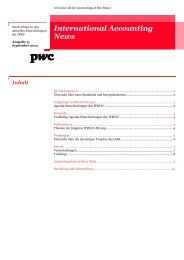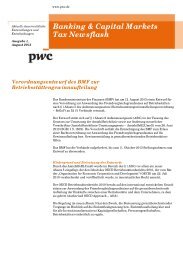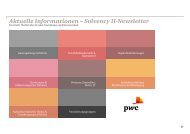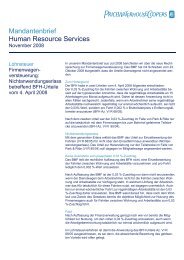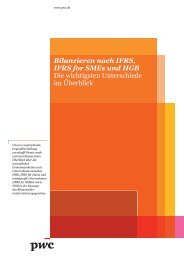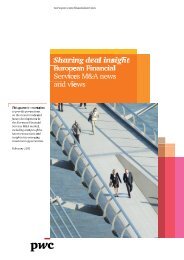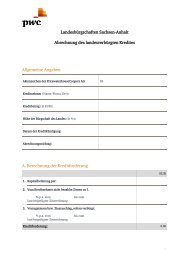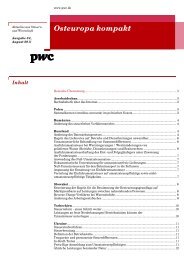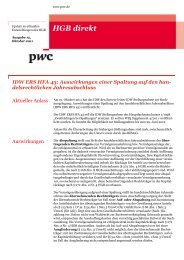Emerging Trends in Real Estate® Europe 2012 - PwC
Emerging Trends in Real Estate® Europe 2012 - PwC
Emerging Trends in Real Estate® Europe 2012 - PwC
Create successful ePaper yourself
Turn your PDF publications into a flip-book with our unique Google optimized e-Paper software.
ExHIBIT 2-5<br />
Debt Underwrit<strong>in</strong>g <strong>in</strong> <strong>2012</strong><br />
Standards Will Become<br />
More Rigorous 85%<br />
Source: <strong>Emerg<strong>in</strong>g</strong> <strong>Trends</strong> <strong>in</strong> <strong>Real</strong> Estate <strong>Europe</strong> <strong>2012</strong> survey.<br />
Standards Will Become<br />
Less Rigorous 1%<br />
Standards Will Rema<strong>in</strong><br />
the Same 13%<br />
<strong>Europe</strong>, and <strong>in</strong>ternational lenders are retreat<strong>in</strong>g to their home<br />
markets. One Spanish <strong>in</strong>terviewee described the approach of<br />
the banks <strong>in</strong> Spa<strong>in</strong> as “f<strong>in</strong>ancial strangulation.”<br />
But the problems are widespread, and lend<strong>in</strong>g will be<br />
curtailed throughout <strong>Europe</strong>. Many <strong>in</strong>terviewees <strong>in</strong> Central<br />
and Eastern <strong>Europe</strong> (CEE) were particularly nervous about<br />
the availability of debt, cit<strong>in</strong>g the concern that German and<br />
Austrian lenders, who had been very active <strong>in</strong> the market,<br />
were curtail<strong>in</strong>g their activity. One borrower commented:<br />
“Everyth<strong>in</strong>g we heard four years ago is com<strong>in</strong>g to pass.<br />
Austrian banks have been told to stop lend<strong>in</strong>g to CEE. Last<br />
year’s good news seems a long way away. The crisis is back<br />
with a vengeance.”<br />
Many <strong>in</strong>terviewees commented on the likely behaviour<br />
of German lenders. The announcement <strong>in</strong> November that<br />
Eurohypo had been told by its parent, Commerzbank, to cease<br />
lend<strong>in</strong>g had come as a shock to some <strong>in</strong>terviewees whilst<br />
others felt that this situation had been foreseen for some time.<br />
Either way, that and other decisions taken by the German<br />
banks were widely seen as highly significant because they had<br />
been such active lenders across <strong>Europe</strong>. A typical comment<br />
from an <strong>in</strong>terviewee was, “Banks that can raise money on the<br />
Pfandbrief market are still active, but not like they were before.”<br />
The view among <strong>in</strong>terviewees, <strong>in</strong>clud<strong>in</strong>g the lenders themselves,<br />
was that they would be retrench<strong>in</strong>g heavily and what<br />
new lend<strong>in</strong>g they did would concentrate on core assets<br />
<strong>in</strong> Germany.<br />
This situation was a concern not only to borrowers elsewhere,<br />
but also to some German lenders themselves who saw<br />
a risk of banks all want<strong>in</strong>g to lend on the same narrow band<br />
of assets. As an <strong>in</strong>terviewee from one German bank noted,<br />
“Most of our competitors are clos<strong>in</strong>g down their <strong>in</strong>ternational<br />
bus<strong>in</strong>ess or at least downsiz<strong>in</strong>g and refocus<strong>in</strong>g on the German<br />
market, so we expect stronger competition <strong>in</strong> our core German<br />
segment.” This is a positive development if you are an equity<br />
<strong>in</strong>vestor look<strong>in</strong>g to buy core German assets with low levels of<br />
gear<strong>in</strong>g but is less good news for everyone else.<br />
Debt is go<strong>in</strong>g to be not only <strong>in</strong> short supply but also<br />
expensive. The f<strong>in</strong>anc<strong>in</strong>g cost for banks has risen significantly,<br />
even without the capital cost of meet<strong>in</strong>g regulatory capital<br />
requirements. The dramatically <strong>in</strong>creased cost to the banks<br />
is be<strong>in</strong>g passed on to borrowers, result<strong>in</strong>g <strong>in</strong> what one <strong>in</strong>ter-<br />
Chapter 2: <strong>Real</strong> Estate Capital Markets<br />
viewee described as “eye-water<strong>in</strong>g marg<strong>in</strong>s” over base rates.<br />
Interviews with borrowers and lenders alike suggested that<br />
these costs are unlikely to decrease <strong>in</strong> the short term.<br />
Deleverag<strong>in</strong>g. As already discussed, banks are subject<br />
to very significant regulatory pressure to reduce their assets<br />
to meet capital requirements, and the view is widespread that<br />
commercial real estate lend<strong>in</strong>g will be disproportionately hit<br />
by this asset reduction. Whilst some <strong>in</strong>terviewees believe it<br />
will release a torrent of opportunity, others are more sceptical.<br />
The banks face a dilemma. As one lender said, “We cannot<br />
just dump assets because it would create a self-perpetuat<strong>in</strong>g<br />
downward spiral. The numbers are enormous.” This sense<br />
of caution is reflected <strong>in</strong> other <strong>in</strong>terviews with bankers. One<br />
<strong>in</strong>terviewee from a bank <strong>in</strong> the midst of an active deleverag<strong>in</strong>g<br />
programme commented as follows: “My view is that you have<br />
to be cautious because although we will have short-term dark<br />
spaces over the next six months, th<strong>in</strong>gs will recover. There is<br />
sufficient activity that will keep the market mov<strong>in</strong>g. I would be<br />
cautious about next year, but I th<strong>in</strong>k we still have the ability to<br />
sell throughout the year.” As one <strong>in</strong>vestment banker summed<br />
it up, “The trickle will <strong>in</strong>crease <strong>in</strong> pace, but there will be no<br />
tsunami.”<br />
The banks are only part of the lend<strong>in</strong>g pool that needs to<br />
deleverage. The issuance of commercial mortgage-backed<br />
securities (CMBS) peaked <strong>in</strong> <strong>Europe</strong> <strong>in</strong> 2005, 2006, and early<br />
2007, the top of the boom market. Although CMBS were never<br />
as dom<strong>in</strong>ant a part of the market as <strong>in</strong> the United States, these<br />
peak-of-the-market CMBS issuances are now mov<strong>in</strong>g towards<br />
maturity. It is also worth remember<strong>in</strong>g what went <strong>in</strong>to CMBS<br />
conduits at the time. As the 2007 <strong>Emerg<strong>in</strong>g</strong> <strong>Trends</strong> <strong>in</strong> <strong>Real</strong><br />
Estate <strong>Europe</strong> report noted, 2006 issuance was marked by<br />
a more mixed bag of property f<strong>in</strong>d<strong>in</strong>g its way <strong>in</strong>to the CMBS<br />
pool, with one 2007 <strong>in</strong>terviewee comment<strong>in</strong>g, “I th<strong>in</strong>k there’s<br />
a lot of mispriced paper float<strong>in</strong>g about.” Much of this 2006<br />
CMBS debt is due to reach maturity <strong>in</strong> the next three years.<br />
As one lender observed, “The CMBS maturities will start to<br />
trickle out next year, but the fortunate th<strong>in</strong>g is that the bondholders<br />
will take a hit on that, not the banks.” Interviewees<br />
closest to the epicentre tended to be more sceptical that the<br />
unw<strong>in</strong>d<strong>in</strong>g of CMBS positions would result <strong>in</strong> a flood of assets<br />
onto the market. As one commented: “I th<strong>in</strong>k that many of the<br />
CMBS issues will also be worked through. Although it is a lot<br />
more complicated than bank lend<strong>in</strong>g, many are be<strong>in</strong>g worked<br />
through and bonds extended. We are bondholders <strong>in</strong> a number.<br />
Although some may fail, it will be a m<strong>in</strong>ority.”<br />
Several <strong>in</strong>terviewees identified an issue that has been<br />
restrict<strong>in</strong>g and may cont<strong>in</strong>ue to restrict the banks from tak<strong>in</strong>g<br />
action: the impact of break costs for <strong>in</strong>terest-rate swaps. The<br />
fall <strong>in</strong> variable-rate <strong>in</strong>terest rates has left swaps <strong>in</strong>to fixed rates<br />
out of the money. The prognosis of low <strong>in</strong>terest rates for the<br />
foreseeable future means that little prospect exists of this<br />
revers<strong>in</strong>g, leav<strong>in</strong>g borrowers fac<strong>in</strong>g significant break costs.<br />
This has been accentuated by borrowers’ widespread prac-<br />
<strong>Emerg<strong>in</strong>g</strong> <strong>Trends</strong> <strong>in</strong> <strong>Real</strong> Estate ® <strong>Europe</strong> <strong>2012</strong><br />
19



